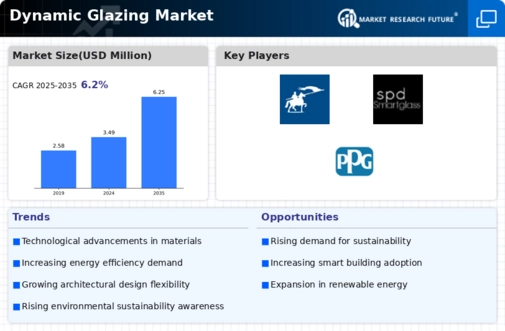Technological Advancements
Technological innovations play a pivotal role in the expansion of the Global Dynamic Glazing Market Industry. Recent advancements in materials and manufacturing processes have led to the development of more efficient and responsive dynamic glazing products. For instance, the integration of smart technologies allows for real-time adjustments to light and heat, enhancing user comfort and energy savings. As these technologies evolve, they are likely to attract more investments and applications across various sectors. The anticipated growth from 2024 to 2035, with a projected market size of 6.25 USD Billion, indicates that ongoing research and development will continue to drive market dynamics.
Growing Demand for Energy Efficiency
The Global Dynamic Glazing Market Industry experiences a notable surge in demand driven by the increasing emphasis on energy efficiency in buildings. As energy costs rise, both residential and commercial sectors are seeking solutions that reduce energy consumption. Dynamic glazing technologies, which adjust their tint based on sunlight exposure, offer a promising solution. In 2024, the market is projected to reach 3.49 USD Billion, reflecting a growing trend towards sustainable building practices. This shift is further supported by government incentives aimed at promoting energy-efficient technologies, suggesting a robust future for dynamic glazing as a key component in energy-efficient architecture.
Diverse Applications Across Various Sectors
The versatility of dynamic glazing technologies contributes to their expanding presence in the Global Dynamic Glazing Market Industry. These products find applications in a wide range of sectors, including residential, commercial, and automotive industries. For example, dynamic glazing is increasingly utilized in skyscrapers to enhance energy efficiency and aesthetic appeal. Additionally, the automotive sector is adopting these technologies to improve passenger comfort and vehicle efficiency. This diverse applicability not only broadens the market scope but also encourages innovation and competition among manufacturers, indicating a dynamic future for the industry.
Rising Awareness of Indoor Environmental Quality
There is a growing recognition of the importance of indoor environmental quality (IEQ) in the Global Dynamic Glazing Market Industry. Enhanced IEQ is linked to occupant health, productivity, and overall well-being, prompting architects and builders to integrate dynamic glazing solutions into their designs. These technologies help regulate natural light and temperature, thereby improving comfort levels within buildings. As awareness of IEQ continues to rise, the demand for dynamic glazing is expected to increase, further propelling market growth. This trend aligns with the broader movement towards healthier living and working environments, suggesting a promising outlook for the dynamic glazing sector.
Regulatory Support for Sustainable Building Practices
The Global Dynamic Glazing Market Industry benefits significantly from regulatory frameworks that promote sustainable building practices. Governments worldwide are increasingly implementing stringent building codes and standards aimed at reducing carbon footprints. These regulations often encourage the adoption of dynamic glazing technologies, which contribute to energy savings and improved indoor environments. As a result, the market is likely to see accelerated growth, with a compound annual growth rate of 5.45% projected from 2025 to 2035. This regulatory support not only enhances market viability but also aligns with global sustainability goals, fostering a conducive environment for dynamic glazing adoption.














Leave a Comment